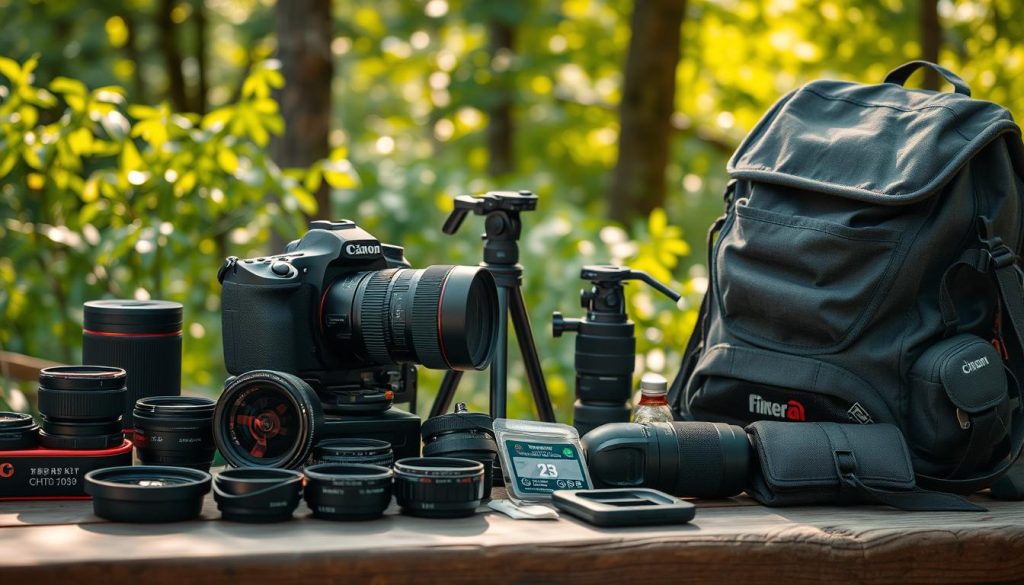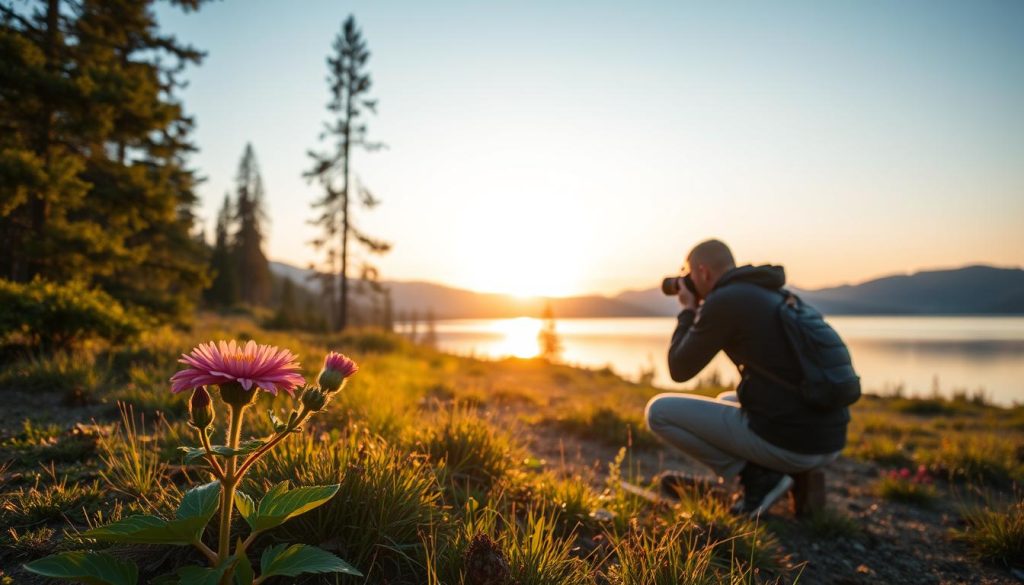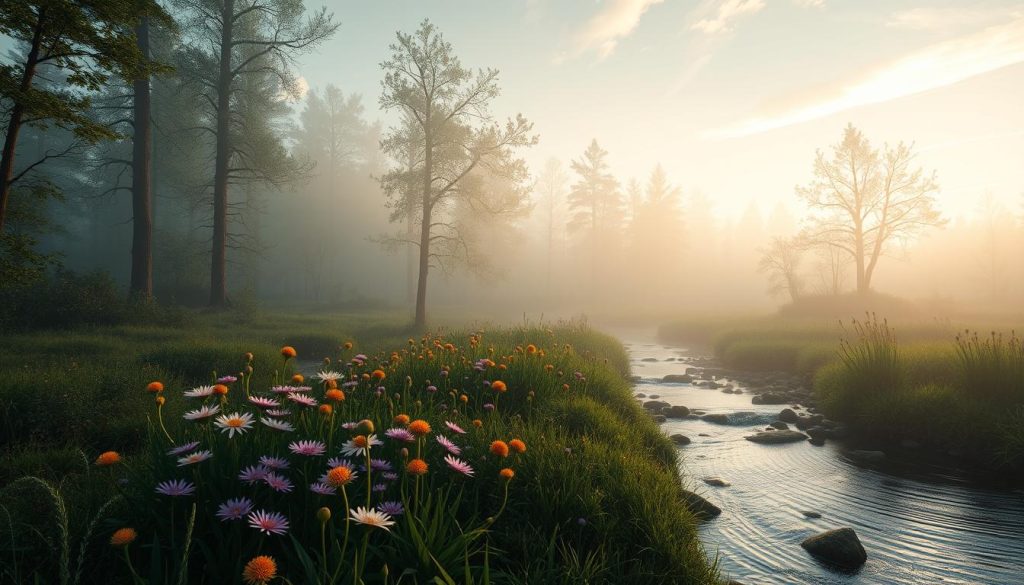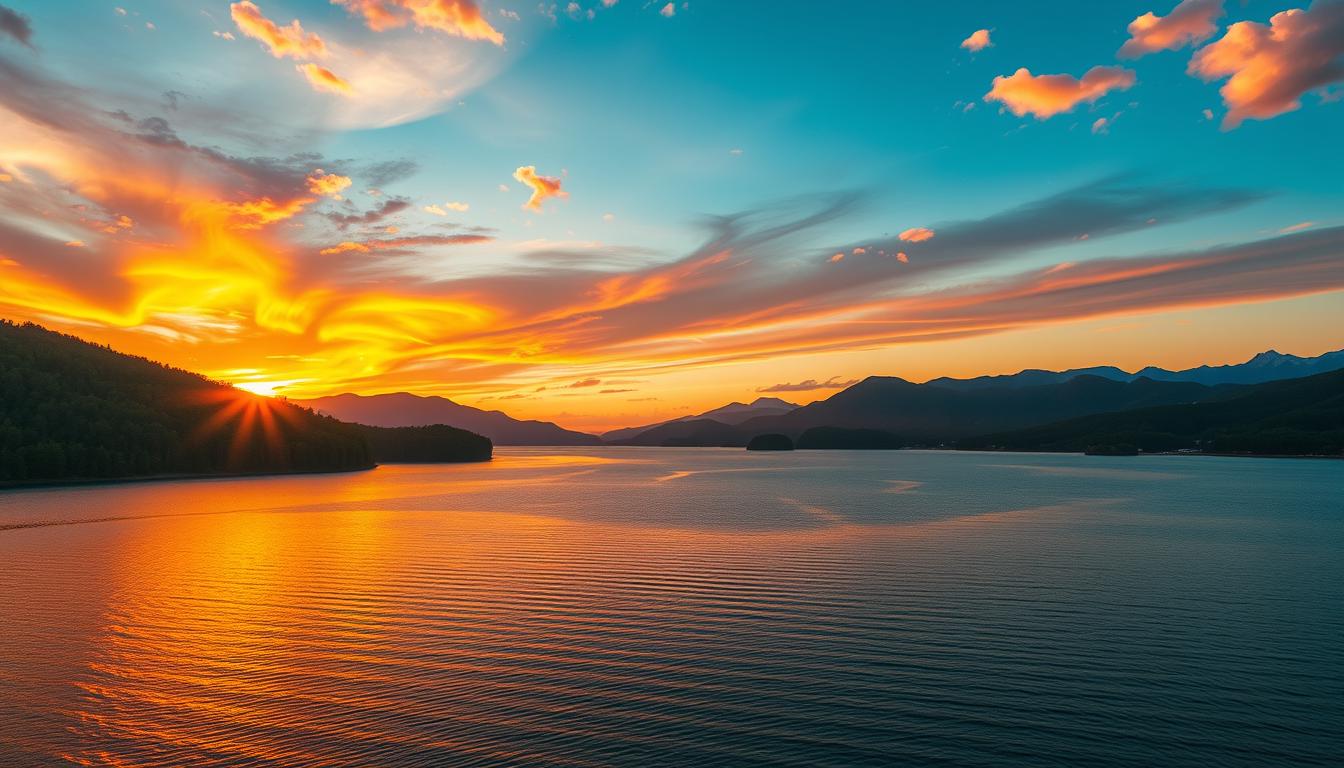I’m excited to share my love for nature photography with you. In this guide, you’ll learn how to capture the beauty of our world. We’ll explore the outdoors and find amazing sights, from landscapes to wildlife. This article is for everyone, whether you’re new or experienced, to inspire you to see the world in a new way.
We’ll discover the magic of nature photography together. We’ll look at different places and find the beauty that’s all around us. You’ll learn how to take great photos, capturing moments that show the beauty of our world.
Let’s start this adventure and learn how to be a great nature photographer. Get ready to explore the outdoors and take photos that show Earth’s beauty.
The Magic of Nature Photography
Exploring nature and capturing it with your camera is amazing. As a nature photography fan, I’ve found joy in the outdoors. I love finding beauty in the unexpected.
Exploring the Great Outdoors with a Camera
The natural world is full of beauty, waiting to be captured. You can find amazing shots in forests, by lakes, or on mountains. Being in the moment helps you find stunning photos.
Finding Beauty in the Unexpected
Outdoor photography is all about finding hidden gems. A small wildflower, a special light play, or a bird in flight can be breathtaking. With an open mind, you can find incredible shots.
With a camera, we can share nature’s beauty with everyone. So, grab your camera and explore. Nature photography’s magic is waiting for you.
Mastering the Art of Composition
Capturing the beauty of nature is more than just taking pictures. It’s about using composition to guide the viewer’s eye. This art form is key for nature photographers to make images that inspire.
The rule of thirds is a basic but powerful rule. It divides the frame into nine parts. By placing your subject on these lines, you make your photo balanced and pleasing.
Leading lines are another great tool. They can be a river, trees, or a road. They lead the viewer’s eye into the scene, adding depth and story.
Framing is also crucial. It uses elements to highlight your subject. A window, archway, or tree branches can add drama to your photos.
Symmetry brings balance and peace to your photos. It works well with reflections or nature’s patterns. It makes your photos calm and serene.
Remember these composition tips when you’re out with your camera. Mastering the rule of thirds, leading lines, framing, and symmetry will help you create stunning nature photos.
Nature photography

Capturing the beauty of nature needs the right tools. As a nature photographer, I’ve found that good camera gear is key. You’ll need versatile lenses and sturdy tripods to take amazing photos outdoors.
Cameras and Lenses
Your camera is the heart of your kit. Choose a DSLR or mirrorless with manual controls and high-resolution sensors. Get lenses for different shots, like wide-angle landscapes and telephoto wildlife photos.
Invest in a wide-angle, standard zoom, and telephoto lens. This way, you’re ready for any photo opportunity.
Tripods and Stabilization
A good tripod is essential for nature photos, especially in low light. Find one that’s light but strong, with adjustable legs and a fluid head. Add a remote shutter release or camera stabilizer for even smoother shots.
Filters and Accessories
Filters can make your photos better. Neutral density filters are great for long exposures, and polarizing filters reduce glare. Don’t forget a lens hood, cleaning kit, and a strong camera bag to protect your gear.
With the right equipment, you’re set to capture nature’s beauty. You’ll be able to take stunning photos that inspire and amaze your viewers.
| Equipment | Recommended Features |
|---|---|
| Camera | DSLR or mirrorless system with manual controls, high-resolution sensor, and reliable autofocus |
| Lenses | Wide-angle, standard zoom, and telephoto lenses for versatile shooting |
| Tripod | Lightweight, durable, and with adjustable legs and fluid head for smooth panning and tilting |
| Filters | Neutral density filters for long exposures, polarizing filters to reduce glare and enhance color |
| Accessories | Lens hood, cleaning kit, and sturdy camera bag to protect your equipment |
Capturing the Fleeting Moments

Nature is always moving, showing us beauty and wonder quickly. As photographers, we must catch these moments and keep them forever. Patience and persistence are key to doing this well.
Patience and Persistence: Keys to Success
Getting the perfect wildlife or landscape shot takes patience and knowing your subject. Waiting for the right moment is crucial. This is how you build great nature photography.
But patience isn’t enough. Persistence means keeping at it, trying again and again. The best nature photography comes from those who face challenges and never give up.
For wildlife photography or landscape photography, patience and persistence are essential. They help you find and capture nature’s stunning moments. With these qualities, your photography journey will be filled with discovery and growth.
Embracing the Elements

As nature photographers, we must learn to embrace the ever-changing elements that shape our surroundings. From dramatic skies and dramatic lighting to unpredictable weather conditions, mastering the art of nature photography requires adaptability and a deep appreciation for the forces of nature.
One of the most captivating aspects of outdoor photography is the way the weather can transform a scene. A sudden storm can bring dramatic clouds and lighting, while a golden hour sunset can bathe a landscape in a warm, ethereal glow. By understanding the patterns and cycles of the natural world, we can position ourselves to capture these fleeting moments of beauty.
Whether you’re chasing the perfect storm or waiting patiently for the sun to break through the clouds, the key to success is staying flexible and attuned to the subtle shifts in the environment. By learning to read the weather and anticipate changes in lighting, you can position yourself to capture the true essence of the natural world.
Of course, embracing the elements doesn’t come without its challenges. Inclement weather can make outdoor photography a physically demanding endeavor, requiring specialized gear and a willingness to brave the elements. But for those who are willing to take on the challenge, the rewards can be truly breathtaking.
Mastering the Art of Anticipation
One of the most important skills in nature photography is the ability to anticipate and respond to changing conditions. This may involve monitoring weather forecasts, studying the patterns of light and shadow, or simply being attuned to the subtle cues in your surroundings.
- Learn to read the weather patterns and forecast changes in lighting and conditions.
- Experiment with different camera settings and techniques to capture the nuances of changing light and weather.
- Be prepared to adjust your plans and approach on the fly as the elements shift and evolve.
| Weather Conditions | Ideal Lighting Conditions | Recommended Camera Settings |
|---|---|---|
| Overcast skies | Soft, diffused light | Slower shutter speed, medium aperture |
| Stormy weather | Dramatic, high-contrast lighting | Faster shutter speed, smaller aperture |
| Golden hour | Warm, directional light | Slower shutter speed, wider aperture |
By embracing the ever-changing elements of the natural world, we can unlock a new level of depth and authenticity in our nature photography. Whether you’re chasing the perfect storm or basking in the warm glow of a sunset, the key is to stay adaptable, observant, and open to the endless possibilities that the great outdoors has to offer.
Ethical Considerations in Nature Photography
We have a big responsibility as nature lovers and photographers. We must respect and protect the ecosystems we photograph. Our goal is to capture stunning views and wildlife while caring for the environment.
Respecting the Natural World
When we take photos in nature, we need to be careful. We should stay on trails and not get too close to animals. Never touch plants or animals. This way, we help protect the environment.
It’s also key to think about how our photography affects nature. Using small tripods can help avoid damaging the ground. This way, we can keep the places we photograph beautiful for others to see.
- Stick to designated trails and avoid straying into sensitive areas
- Maintain a respectful distance from wildlife and refrain from interacting with them
- Minimize the use of flash and other disruptive photographic techniques
- Dispose of all waste properly and leave no trace of our presence
By following these nature photography ethics, we can enjoy capturing nature’s beauty. We won’t harm the very places we love to photograph.
Post-Processing: Enhancing Your Vision
After taking your amazing nature photos, post-processing can make them even better. I love using Lightroom and Photoshop to enhance my photos. These tools help me show the true beauty of what I’ve seen.
In Lightroom, I adjust colors, contrast, and clarity. This makes sure every detail is clear. Photoshop lets me add depth and texture to my photos. It makes them look even more real.
Post-processing is more than just changing things. It’s about staying true to my vision. By editing my photos, I make them more emotional and powerful. It’s a mix of my creativity and the tools I use, bringing my photos to life.

